The Indian Child Goes To School
CHAPTER IV
A
COMPARISON OF THE ACHIEVEMENT OF PUPILS BY RACE-SCHOOL GROUPS
WHAT
IS BEING COMPARED?
It is natural and inevitable, we suppose, that
people generally should be interested in comparing school children
of different
races with each other. Certainly any teacher who has worked very
long with Indian children is accustomed to being asked by interested
or merely curious laymen to make such comparisons. Most often the
teacher is asked whether the Indian pupil is as intelligent as
his white classmate. This is indeed a difficult question to answer,
for the inquirer usually has no intention of sitting patiently
while the teacher explains that anthropologists and ethnologists
are pretty well agreed that race alone is not a determining factor
in intelligence and that no one race has a monopoly on all the
brains in the world. The questioner becomes increasingly restless
as the teacher goes on to say that we have no really suitable tests
for measuring the intelligence of Indian pupils since the ones
available are based largely on English verbalism and are loaded
with questions pertaining to the dominant culture of the country.
The chances are good that all the questioner really wanted to know
was whether Indian children do "as well" in school as
non-Indian children. Many laymen tend to equate school success
with intelligence; that is, they assume that intelligence is the
sole factor which influences learning. This is far from true. Some
of tile other factors which are believed to influence learning
will be discussed in Chapter VI. .
In any case no intelligence test data were obtained in the present
study. The tests used were achievement tests. Achievement tests
seek to measure how much or how well a child has learned. Intelligence
tests attempt to discover his mental capacity for learning.
Why Intelligence Tests Were Not Given
Some readers may feel that, inasmuch as intelligence is admittedly
an important factor in the learning process, not attempting to
measure it was a serious omission. The plain fact is that, in the
opinion of the investigators, a valid measurement of the intelligence
of pupils was not possible in the present study. First of all,
it would have been necessary to use a group test which could have
been scored by machine. Furthermore it would have hall to be usable
for children from arc nine years to adulthood. Nearly all group
intelligence tests are highly verbal. Those which claim to be non-verbal
in content must rely on verbalism in the giving of directions.
Nearly all intelligence tests, individual as well as those of the
group type, contain items drawn from the major culture of the country.
This, it was felt, would operate against the underacculturated
groups in the study, both Indian anti white. No instrument was
found which satisfied all of the requirements and contained none
of the disadvantages mentioned above.
Differences in the Measuring of Intelligence and Achievement
We accept the concept of innate mental capacity, which differs
qualitatively and quantitatively from individual to individual,
as a valid one. It would he very helpful in educational situations
if we could measure it as such. In truth, however, we have never
been able to do this. From the moment of birth environmental influences
begin to act upon the individual. These do not change his innate
capacity but they prevent the accurate measurement of it. The same
language handicaps or other cultural disadvantages which adversely
affect the educational achievement of a child would tend to influence
his intelligence test scores. Achievement tests on the other hand
are designed to cover material which presumably has been “taught” in
school. By use of them we simply seek to discover how much the
child has learned. They are not invalidated merely because the
learner faces learning disadvantages, so long as the content is
consistent with the courses of study and the learning goals of
the school which the child attends. No such validity can be claimed
for a verbalized, culture laden, group test which purports to measure
the innate mental capacity of an under-acculturated child.
THE COMPOSITION OF THE RACE-SCHOOL GROUPS
As was described in Chapter 11, the population of Indian children
in the present study was composed of pupils in three different
types of schools: Federal, public, and mission. Through the generous
and excellent help of many public and mission school administrators
and teachers, rather large numbers of Indian pupils were tested
in both public and mission schools, as well as a large number of
white children in public schools. Table 4-a shows the composition
of the entire population tested by areas, grades, and race-school
groups.
Does Type of School Administration Affect Achievement?
Again it is inevitable that there should be interest in the relative
levels of achievement of Indian pupils in the three types of schools.
There is a rather popular supposition that these school types differ
from each other quite radically in point of curriculum, qualifications
of teachers, teaching methods and materials, and educational goals,
simply because they operate under separate administrative authorities.
These differences are more often imaginary than real as anyone
who takes the trouble to investigate will discover. This is particularly
true for the elementary grades and for the basic skills which were
measured in this study. It would be more logical and accurate to
assume, unless there is strong evidence to the contrary, that all
three types of schools draw upon the common pool of educational “know
how” which has been developed in American schools.
()f course, it is necessary for the school, of whichever administrative
type it may be, to modify its instructional program to meet the
needs of those pupils who enter school unable to speak any English
or who speak it poorly. Federal schools in the Phoenix, Albuquerque,
Billings, and Muskogee Area have a high percentage of such beginning
pupils as do mission schools in the Phoenix and Albuquerque Areas.
Public schools have faced this problem less frequently than have
the Federal and mission schools. It is mandatory that instructional
procedures, techniques, and materials be adapted to the needs of
the non-English-speaking beginner.
THE ORDER OF ACHIEVEMENT OF RACE-SCHOOL GROUPS
Nevertheless, and in spite of what has been pointed out in the
section lust preceding. the four race-school groups do arrange
themselves .into a fairly definite hierarchy or order of achievement
as follows:
1. White children in public schools
2. Indian children in public schools
3. Indian children in Federal schools
4. Indian children in mission schools
Method of Establishing the Hierarchy
Table 4-b shows the hierarchy for each of the areas separately.
These were determined by exactly the same method employed in Chapter
III in determining the hierarchy
of achievement for the six areas. Here a comparison was made of the mean raw
scores of the race-school groups for each of the six skills, and total score,
for each of the nine grades in each area. One minor exception to this occurred
in the Billings Area where there were no Federal school pupils
in grades eleven and twelve, and so they could
he compared with the other race-school groups only through grade
ten. Normalized standard scores were assigned to the ranks of
the means for race-school groups in each grade. These scores
were then averaged for each group. Except where noted in Table
4-b, differences between the means of standardized scores assigned
to race-school groups were statistically significant.1
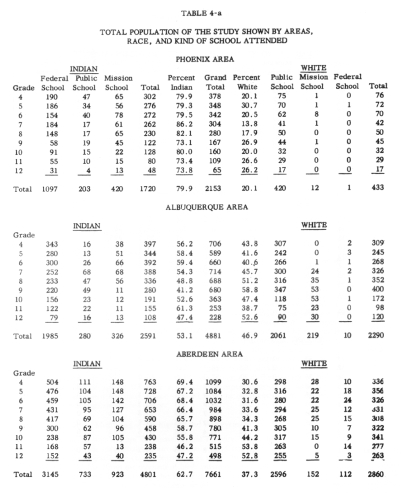
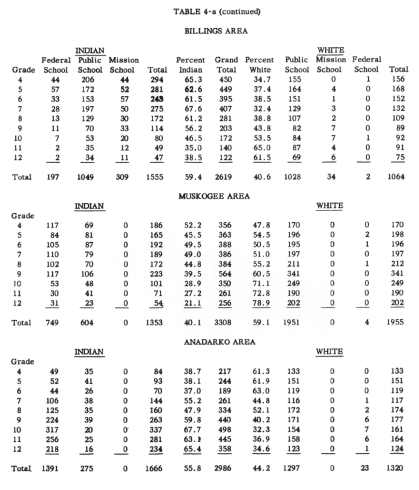
Two Exceptions to the General Hierarchy
An inspection of Table 4-b will reveal that the Phoenix and Billings
Areas conform exactly to the general hierarchy outlined above.
So do the Anadarko and Muskogee Areas, except that there were no
mission school pupils tested in those areas.
In the Aberdeen and Albuquerque Areas, however, exceptions to the
general hierarchy of achievement do occur. In the Aberdeen Area
the over-all achievement of Indian pupils in mission schools did
not differ significantly from that of Indian pupils in public schools.
Both groups were significantly lower than white pupils in public
schools and significantly-higher than Indian pupils in Federal
schools. In the Albuquerque Area, again there was no significant
difference in the over-all achievement of the Indian groups in
mission and public schools, but the Indian pupils in Federal schools
were significantly higher than both. They, in turn, were significantly
lower than the white pupils in public schools. Data shown and-discussed
later in Chapter VI will suggest partial explanations for these
departures from the general hierarchy.
Tables of raw score means and tables of differences in means among
the race-school groups are shown in Appendix C. These are shown
by areas, by grades, and by skills. A careful examination of these
tables by the reader will disclose that they support the hierarchies
as shown in Table 4-b. Raw score mean differences which are statistically
significant are so indicated.
SHOWING DIFFERENCES BY SKILLS AND BY GRADES
It must be remembered that the hierarchy of achievement referred
to above rests upon comparisons of the race-school groups on seven
different skills in nine different grades; sixty-three in all for
each area. The hierarchy of achievement, then, is a general one
and simply reflects the rank ordering of race-school groups which
was most typical of these comparisons. In many of the sixty-three
comparisons in each area, the order of achievement was different
from the general hierarchy.
Average, and Below and Above Average Pupils, Shown by Percentages
The writers hope that in Figures IV-1 through IV-42 a more meaningful
method of depicting differences in achievement among the several
race-school groups has been found than would result from an examination
of the bare tables of raw-score means. In these figures much the
same scheme is employed as was used in Figures III-4 through III-12
in the preceding chapter. The principal difference is that here
the various race-school groups are compared, within each area,
with the norm group of that area. Such norm groups are composed
of all the children tested in a-given grade in that area. In Figures
III-4 through III-12, it will be recalled, a composite norm group
made up of all the children in a grade in this study was used for
purposes of comparing achievement in the several areas.
Let us use Figure IV-1 as an example. We will consider the middle
68 percent of the scores of all the fourth-grade students who were
tested on reading vocabulary in the Phoenix Area to be average,
the lowest 16 percent to be below average, and the highest 16 percent
to be above average. By comparison, then, we reach the following
conclusion about the white pupils who attended the fourth grade
in public schools: 53.3 percent were average, 18.7 percent were
below average, and 28 percent were above average.
TABLE
4-b
HIERARCHY OF EDUCATIONAL ACHIEVEMENT BY RACE
SCHOOL GROUPS
IN SIX ADMINISTRATIVE AREAS OF THE BUREAU OF INDIAN AFFAIRS
PHOENIX AREA
1. White pupils in public
schools
2. Indian pupils in public schools
3. Indian pupils in
Federal schools
4. Indian pupils in mission schools
|
BILLINGS AREA
1. White pupils in public schools
2. Indian pupils in
public schools
3. Indian pupils in Federal schools
4. Indian pupils in
mission schools
|
ABERDEEN AREA
1. White pupils in public schools
2-3 Indian pupils in
mission schools) No significant Indian pupils in public
schools ) difference
4. Indian pupils in Federal schools
|
ALBUQUERQUE AREA
1. White pupils in public schools
2. Indian pupils in
Federal schools
3-4 Indian pupils in public schools )
No significant Indian pupils in mission schools) difference
|
MUSKOGEE AREA
1. White pupils in public schools
2. Indian pupils in
public schools
3. Indian pupils in Federal schools
|
ANADARKO AREA
1. White pupils in public schools
2. Indian pupils in
public schools
3. Indian pupils in Federal schools
|
Variations in Rank and Percentages; Overlapping Achievement of
Pupils
An examination of these figures will reveal that the relative positions
of the several race-school groups differ from the general hierarchy
on certain skills and in certain grades. It will further disclose
that the percentages of pupils who are average, or above or below
average, differ for each race-school group from skill to skill
and from grade to grade. And, finally, the reader will observe
the overlap in level of achievement among pupils of the different
groups, with some pupils in each group achieving; higher or lower
than some pupils in each of the other groups.
IMPLICATIONS OF THE GENERAL HIERARCHY
What are some of the implications of the general hierarchy of achievement
of the race-school groups? An obvious one is that generally the
basic skills of Indian pupils are not yet as well developed as
arc those of White children. This is not a new finding for the
studies by Peterson2 and by Anderson,3 et al, revealed the same
thing.
In general, also, Indian children attending public schools achieved
hither in the laic skills than did those attending Federal or mission
schools, although notable exceptions to this pattern have been
observed in the Albuquerque and Aberdeen Areas. What account for
the general superiority in achievement of public school Indian
pupils over the other two groups? Is it because the public schools
arc “better” schools? Are public school Indian pupils “better
taught?” There are always persons who are quick to leap to
such a conclusion even though no reputable accrediting agency evaluates
the quality of a school on the basis of the scores its pupils make
on a standardized achievement test. Accrediting agencies recognize
that in different schools the pupils themselves may vary widely
in point of cultural background. Accrediting agencies, rather,
establish certain evaluative criteria,4 concerning such things
as professional training of teachers, curricula, and teaching materials,
which they believe to be the hallmarks of a good school. To the
extent that a school measures up to these criteria, or falls short
of them, it is considered a good school or a poor one.
The Quality of the School
Of course, some schools are of much better quality than others.
These differences are very wide and they occur over the entire
United States ill all types of schools. Usually the duality of
the school is of the sort that the people of the local community
demand and can or will pay for. To assume, however, that a school
of a given administrative type possesses or lacks qualities of
excellence, per se, is to stray far wide of the mark.
Difference in Cultural Background
Some differences in cultural background of the three Indian groups
in this study will be discussed in detail in Chapter VI. These
differences, in the opinion of the writers, have more to do with
level of achievement than does mere attendance in a school of a
certain administrative type.
Inter-Area Comparisons
The comparison of achievement of the several race-school groups
need not stop at area boundary lines. It is very enlightening to
make inter-area comparisons. For example, the average achievement
of Indian pupils in Federal schools in the Muskogee and Aberdeen
Areas coincides almost exactly at every grade level. On the other
hand the average achievement of white pupils in public schools
in the Aberdeen Area was significantly higher at every grade level
than that of white pupils in the public schools of the Muskogee
Area. This means, of course, that the white and the Indian pupils
are much more like each other with respect to the basic skills
in the Muskogee Area that they are in the Aberdeen Area.
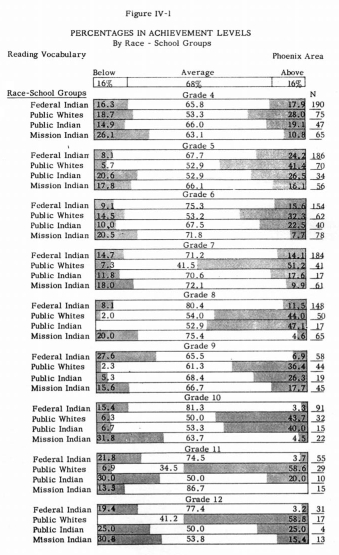
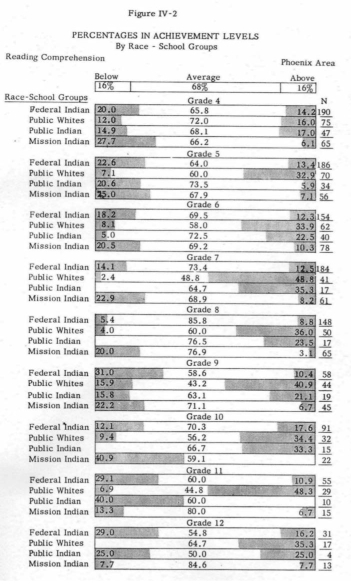
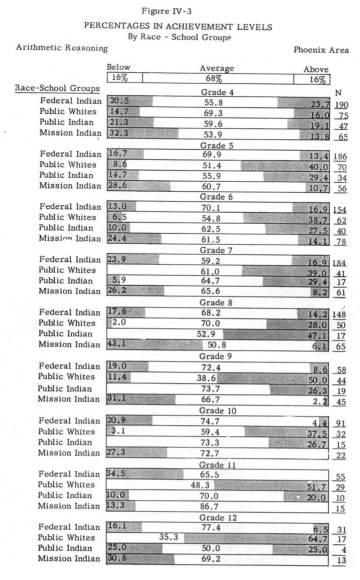

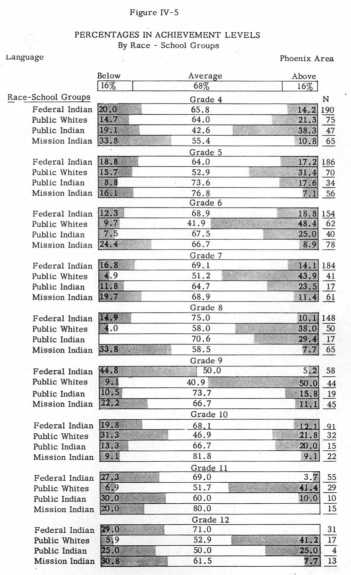
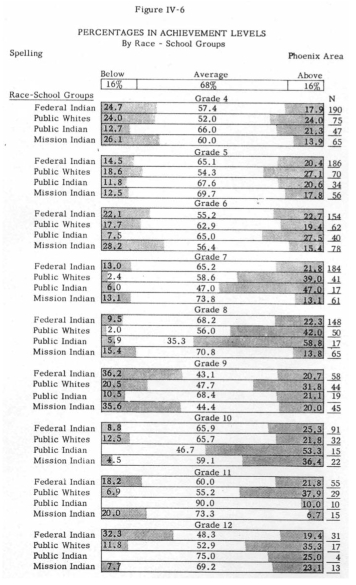

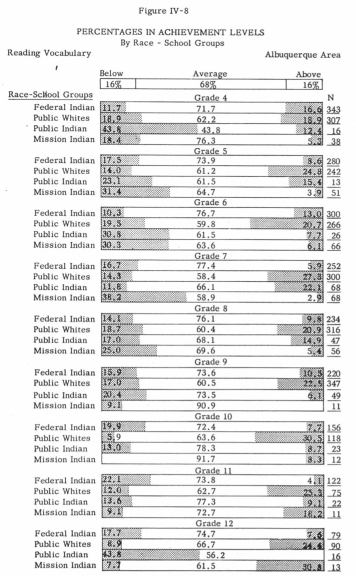
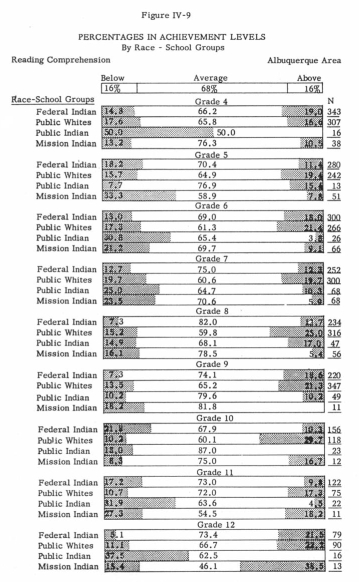
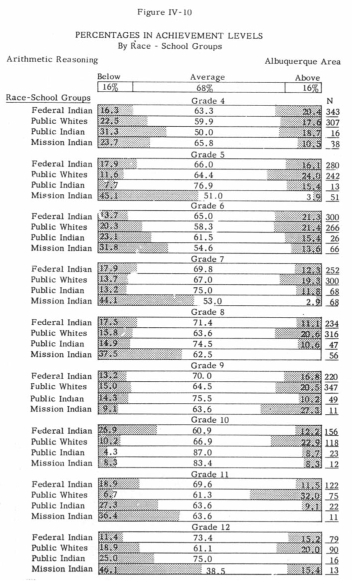

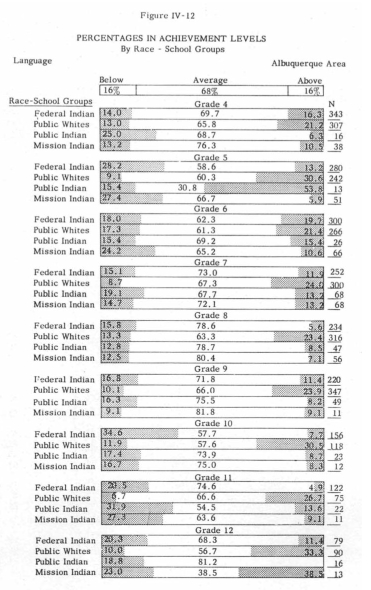
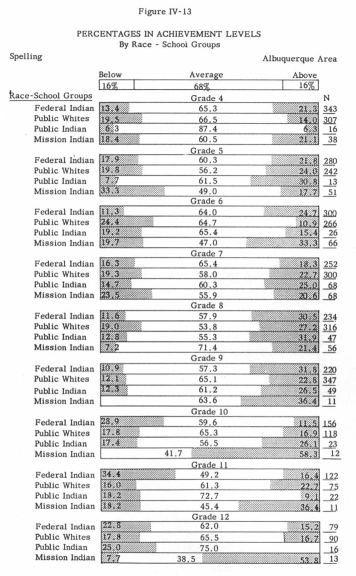
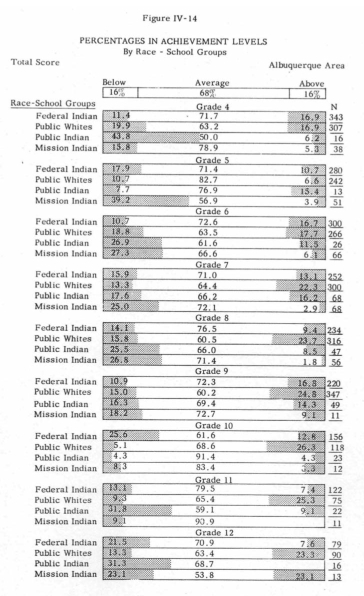

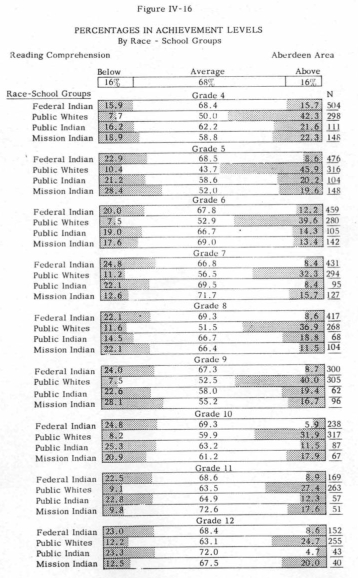
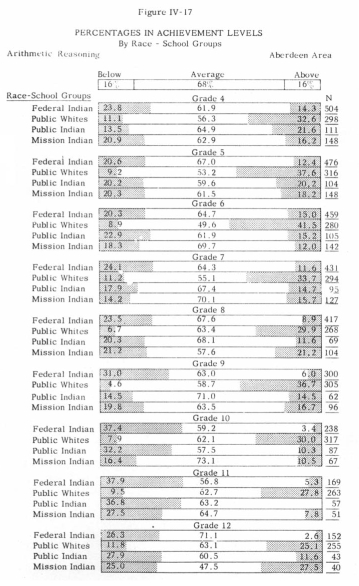
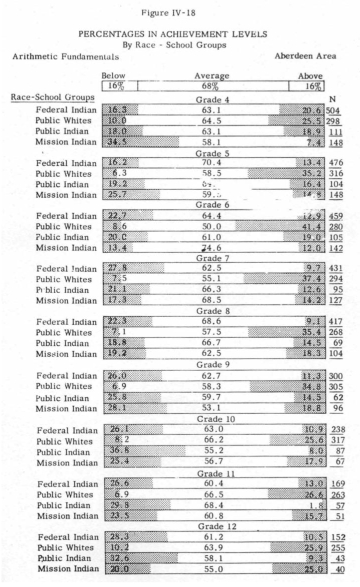
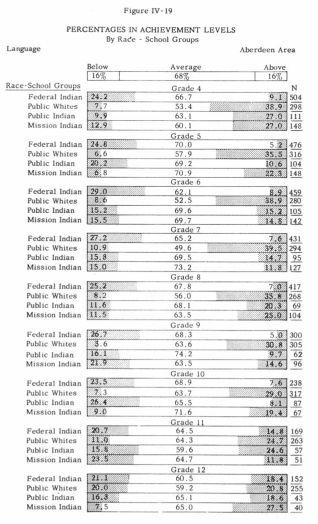

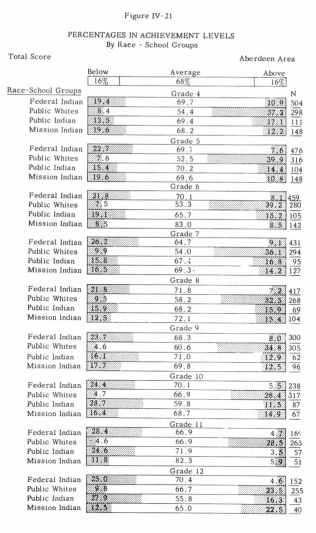
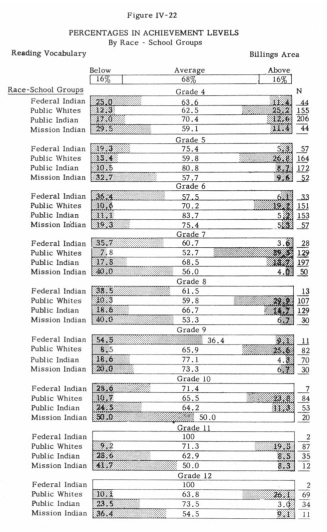
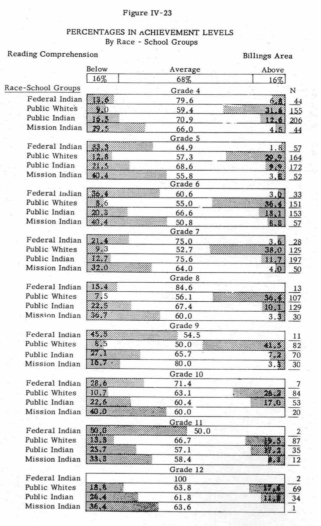


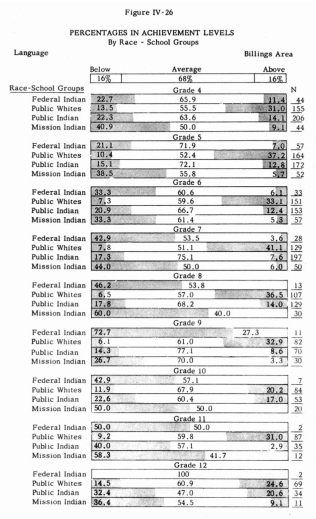
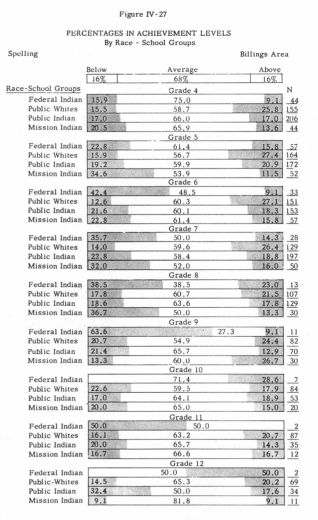
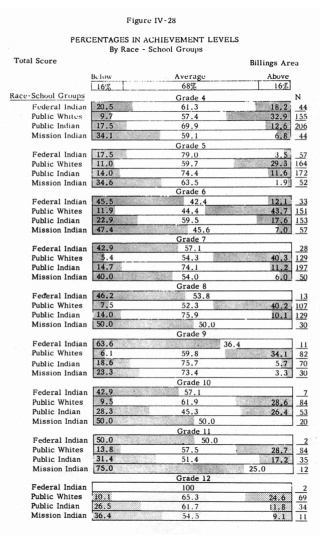
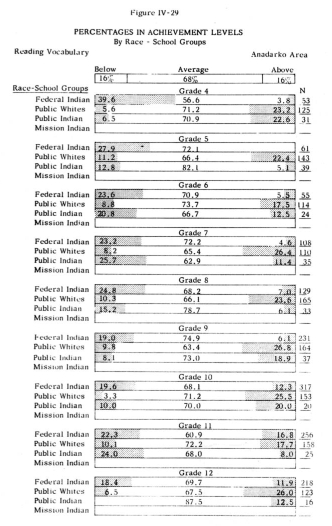
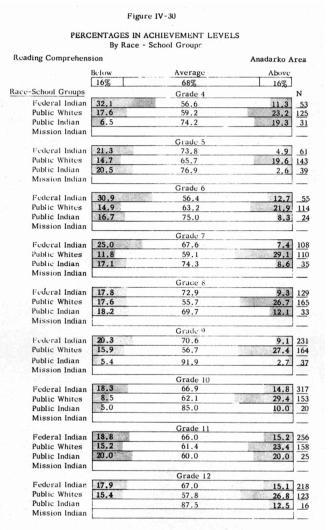



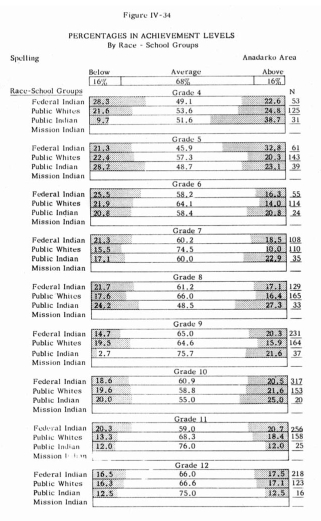
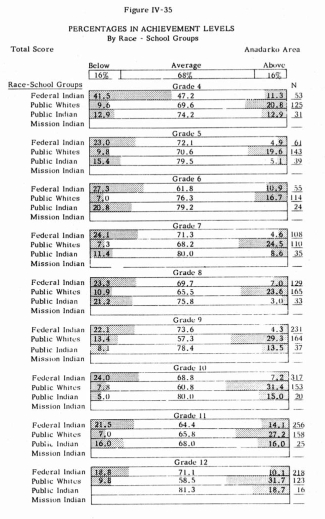

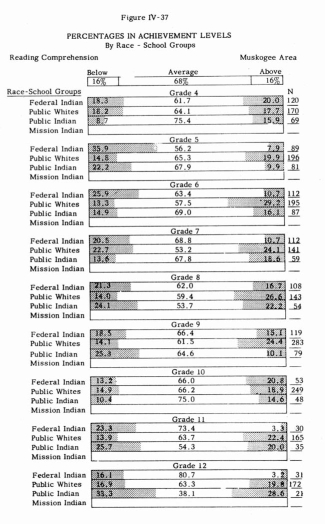
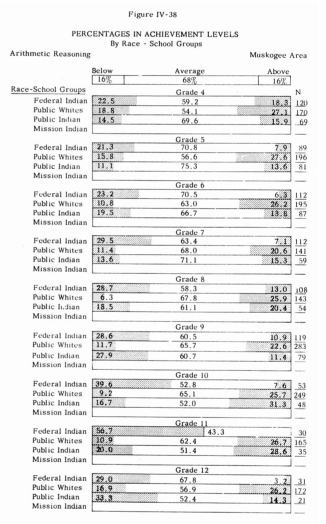
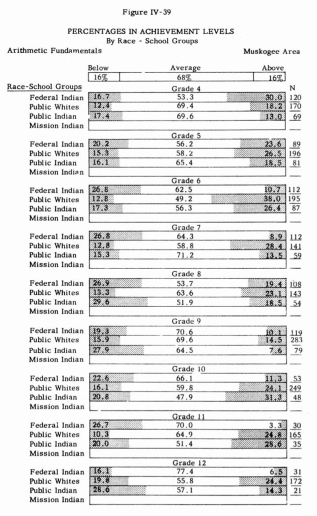
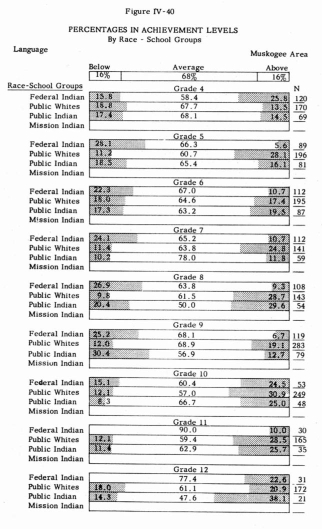

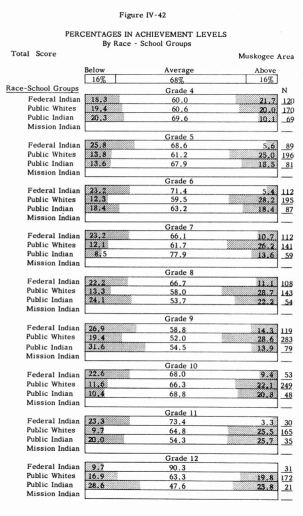
It is also of interest to note that Indian pupils in Federal schools
in the Anadarko Area achieve on the average at about the same level
as white pupils in public schools in the Albuquerque Area in grades
four through nine. Furthermore, the average achievement of Indian
pupils in Federal schools in the Anadarko Area is at least its
high as it is for Indian pupils in public schools in the Billings
Area in grades four through nine. In turn, Indian pupils who attend
mission schools in the Aberdeen Area achieve on the average at
least as high as public school Indian pupils in the Billings Area
at every grade level. An examination of the tables of mean raw
scores in Appendix C will verify the accuracy of the above statements.
The comparisons made in the two paragraphs preceding are by no
means exhaustive but surely they support the contention that type
of school, alone, is not a controlling factor in determining level
of achievement of pupils.
Some Conclusions
The Bureau of Indian Affairs has committed itself to a policy of'
arranging for the transfer of Indian children from Federal to public
schools as rapidly as is feasible. This transfer has been going
on for many years and is at present being accelerated. One reason
for this is that public education in America has historically and
traditionally been a state, and local function. As Indian people
become integrated with the non-Indian community around them, their
children will attend the schools provided by that community. Furthermore,
it seems logical to suppose that as Indian children associate daily
with non-Indian children they will learn from them. This undoubtedly
happens in most cases.
The logic expressed above is trot necessarily irrefutable ill all
cases, however. The social climate of the school to which the Indian
child transfers needs to be hospitable and sympathetic. Teaching
materials and methods need to be adapted to the needs of the Indian
child if his needs are different from those of his non-Indian classmates.
Otherwise he may he repelled by his school experience rather than
helped by it. In any case the unique contribution which the public
school can make to the Indian child, and which the Federal school
is unable to make, is the opportunity to associate with and learn
from the non-Indian pupils.
It would seem wise for the Bureau to evaluate as carefully as it
can the relative levels of educational achievement and acculturation
of the pupils of both the Federal and the public school before
Indian pupils are transferred from one to the other. By so doing
it might avoid educational and cultural gaps which tend to operate
against the success of Indian pupils and may contribute to their
dropping out of school.
1 At the .01 level of confidence.
2 Shailer
Peterson. 1948. How Well Are Indian Children Educated: Haskell
Institute Press.
3 Kenneth E. Anderson, E. Gordon Collister and Carl E. Ladd.
1953. The Educational Achievement of Indian Children.
Haskell Institute Press.
4 For example, the Evaluative Criteria established by the Cooperative Study of
Secondary School Standards and used by
such accrediting agencies as the North Central Association of Colleges and Secondary
Schools.
|